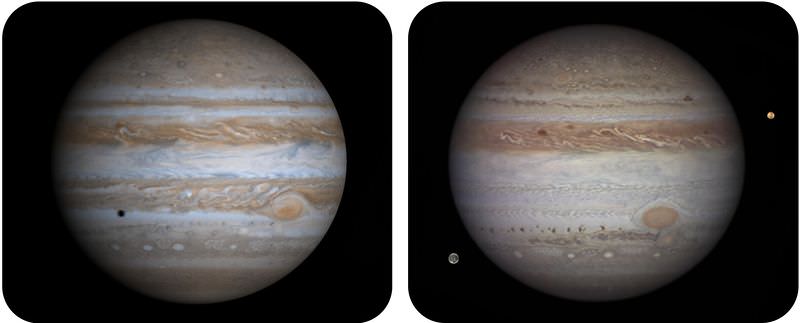3.5: Revoluciones de la Tierra
- Page ID
- 109553
\( \newcommand{\vecs}[1]{\overset { \scriptstyle \rightharpoonup} {\mathbf{#1}} } \)
\( \newcommand{\vecd}[1]{\overset{-\!-\!\rightharpoonup}{\vphantom{a}\smash {#1}}} \)
\( \newcommand{\dsum}{\displaystyle\sum\limits} \)
\( \newcommand{\dint}{\displaystyle\int\limits} \)
\( \newcommand{\dlim}{\displaystyle\lim\limits} \)
\( \newcommand{\id}{\mathrm{id}}\) \( \newcommand{\Span}{\mathrm{span}}\)
( \newcommand{\kernel}{\mathrm{null}\,}\) \( \newcommand{\range}{\mathrm{range}\,}\)
\( \newcommand{\RealPart}{\mathrm{Re}}\) \( \newcommand{\ImaginaryPart}{\mathrm{Im}}\)
\( \newcommand{\Argument}{\mathrm{Arg}}\) \( \newcommand{\norm}[1]{\| #1 \|}\)
\( \newcommand{\inner}[2]{\langle #1, #2 \rangle}\)
\( \newcommand{\Span}{\mathrm{span}}\)
\( \newcommand{\id}{\mathrm{id}}\)
\( \newcommand{\Span}{\mathrm{span}}\)
\( \newcommand{\kernel}{\mathrm{null}\,}\)
\( \newcommand{\range}{\mathrm{range}\,}\)
\( \newcommand{\RealPart}{\mathrm{Re}}\)
\( \newcommand{\ImaginaryPart}{\mathrm{Im}}\)
\( \newcommand{\Argument}{\mathrm{Arg}}\)
\( \newcommand{\norm}[1]{\| #1 \|}\)
\( \newcommand{\inner}[2]{\langle #1, #2 \rangle}\)
\( \newcommand{\Span}{\mathrm{span}}\) \( \newcommand{\AA}{\unicode[.8,0]{x212B}}\)
\( \newcommand{\vectorA}[1]{\vec{#1}} % arrow\)
\( \newcommand{\vectorAt}[1]{\vec{\text{#1}}} % arrow\)
\( \newcommand{\vectorB}[1]{\overset { \scriptstyle \rightharpoonup} {\mathbf{#1}} } \)
\( \newcommand{\vectorC}[1]{\textbf{#1}} \)
\( \newcommand{\vectorD}[1]{\overrightarrow{#1}} \)
\( \newcommand{\vectorDt}[1]{\overrightarrow{\text{#1}}} \)
\( \newcommand{\vectE}[1]{\overset{-\!-\!\rightharpoonup}{\vphantom{a}\smash{\mathbf {#1}}}} \)
\( \newcommand{\vecs}[1]{\overset { \scriptstyle \rightharpoonup} {\mathbf{#1}} } \)
\( \newcommand{\vecd}[1]{\overset{-\!-\!\rightharpoonup}{\vphantom{a}\smash {#1}}} \)
\(\newcommand{\avec}{\mathbf a}\) \(\newcommand{\bvec}{\mathbf b}\) \(\newcommand{\cvec}{\mathbf c}\) \(\newcommand{\dvec}{\mathbf d}\) \(\newcommand{\dtil}{\widetilde{\mathbf d}}\) \(\newcommand{\evec}{\mathbf e}\) \(\newcommand{\fvec}{\mathbf f}\) \(\newcommand{\nvec}{\mathbf n}\) \(\newcommand{\pvec}{\mathbf p}\) \(\newcommand{\qvec}{\mathbf q}\) \(\newcommand{\svec}{\mathbf s}\) \(\newcommand{\tvec}{\mathbf t}\) \(\newcommand{\uvec}{\mathbf u}\) \(\newcommand{\vvec}{\mathbf v}\) \(\newcommand{\wvec}{\mathbf w}\) \(\newcommand{\xvec}{\mathbf x}\) \(\newcommand{\yvec}{\mathbf y}\) \(\newcommand{\zvec}{\mathbf z}\) \(\newcommand{\rvec}{\mathbf r}\) \(\newcommand{\mvec}{\mathbf m}\) \(\newcommand{\zerovec}{\mathbf 0}\) \(\newcommand{\onevec}{\mathbf 1}\) \(\newcommand{\real}{\mathbb R}\) \(\newcommand{\twovec}[2]{\left[\begin{array}{r}#1 \\ #2 \end{array}\right]}\) \(\newcommand{\ctwovec}[2]{\left[\begin{array}{c}#1 \\ #2 \end{array}\right]}\) \(\newcommand{\threevec}[3]{\left[\begin{array}{r}#1 \\ #2 \\ #3 \end{array}\right]}\) \(\newcommand{\cthreevec}[3]{\left[\begin{array}{c}#1 \\ #2 \\ #3 \end{array}\right]}\) \(\newcommand{\fourvec}[4]{\left[\begin{array}{r}#1 \\ #2 \\ #3 \\ #4 \end{array}\right]}\) \(\newcommand{\cfourvec}[4]{\left[\begin{array}{c}#1 \\ #2 \\ #3 \\ #4 \end{array}\right]}\) \(\newcommand{\fivevec}[5]{\left[\begin{array}{r}#1 \\ #2 \\ #3 \\ #4 \\ #5 \\ \end{array}\right]}\) \(\newcommand{\cfivevec}[5]{\left[\begin{array}{c}#1 \\ #2 \\ #3 \\ #4 \\ #5 \\ \end{array}\right]}\) \(\newcommand{\mattwo}[4]{\left[\begin{array}{rr}#1 \amp #2 \\ #3 \amp #4 \\ \end{array}\right]}\) \(\newcommand{\laspan}[1]{\text{Span}\{#1\}}\) \(\newcommand{\bcal}{\cal B}\) \(\newcommand{\ccal}{\cal C}\) \(\newcommand{\scal}{\cal S}\) \(\newcommand{\wcal}{\cal W}\) \(\newcommand{\ecal}{\cal E}\) \(\newcommand{\coords}[2]{\left\{#1\right\}_{#2}}\) \(\newcommand{\gray}[1]{\color{gray}{#1}}\) \(\newcommand{\lgray}[1]{\color{lightgray}{#1}}\) \(\newcommand{\rank}{\operatorname{rank}}\) \(\newcommand{\row}{\text{Row}}\) \(\newcommand{\col}{\text{Col}}\) \(\renewcommand{\row}{\text{Row}}\) \(\newcommand{\nul}{\text{Nul}}\) \(\newcommand{\var}{\text{Var}}\) \(\newcommand{\corr}{\text{corr}}\) \(\newcommand{\len}[1]{\left|#1\right|}\) \(\newcommand{\bbar}{\overline{\bvec}}\) \(\newcommand{\bhat}{\widehat{\bvec}}\) \(\newcommand{\bperp}{\bvec^\perp}\) \(\newcommand{\xhat}{\widehat{\xvec}}\) \(\newcommand{\vhat}{\widehat{\vvec}}\) \(\newcommand{\uhat}{\widehat{\uvec}}\) \(\newcommand{\what}{\widehat{\wvec}}\) \(\newcommand{\Sighat}{\widehat{\Sigma}}\) \(\newcommand{\lt}{<}\) \(\newcommand{\gt}{>}\) \(\newcommand{\amp}{&}\) \(\definecolor{fillinmathshade}{gray}{0.9}\)¿De qué tipo de revolución estamos hablando?
Copérnico provocó una revolución. Dijo que la Tierra giraba alrededor del Sol. Con su telescopio, Galileo encontró mucha evidencia para ello. Podía ver lunas orbitando a Júpiter. Si las lunas pueden orbitar Júpiter, seguramente la Tierra puede orbitar al Sol. ¿Sí? En las dos imágenes anteriores, se puede ver a Júpiter en dos momentos diferentes, mostrando lunas en diferentes lugares.
Revolución de la Tierra
La Tierra orbita una estrella. Esa estrella es nuestro Sol. Una revolución alrededor del Sol toma 365.24 días. Eso equivale a un año. La Tierra permanece en órbita alrededor del Sol debido a la gravedad del Sol (Figura abajo).
La órbita de la Tierra no es un círculo. Es un poco elíptica. Entonces mientras viajamos alrededor del Sol, a veces estamos un poco más lejos del Sol. A veces estamos más cerca del Sol.
Los estudiantes a veces piensan que la forma ligeramente ovalada de nuestra órbita causa las estaciones terrestres. ¡Eso no es cierto! Las estaciones se deben a la inclinación del eje de la Tierra, como se discutió en el concepto anterior.
La Tierra y los demás planetas del sistema solar hacen órbitas elípticas alrededor del Sol. Las elipses en esta imagen son muy exageradas.
La distancia entre la Tierra y el Sol es de unos 93 millones de millas, o 150 millones de kilómetros. La Tierra gira alrededor del Sol a una velocidad promedio de unos 27 kilómetros (17 millas) por segundo. Mercurio y Venus están más cerca del Sol, por lo que tardan tiempos más cortos en hacer una órbita. Mercurio tarda solo unos 88 días terrestres en hacer un viaje alrededor del Sol. Todos los demás planetas tardan más tiempo. La cantidad exacta depende de la distancia del planeta al Sol. Saturno tarda más de 29 años terrestres en hacer una revolución alrededor del Sol. ¿Qué edad tendrías si estuvieras en Júpiter?
Resumen
- La órbita de la Tierra alrededor del Sol es algo elíptica.
- Las estaciones de la Tierra no son causadas por la forma de su órbita.
- La Tierra y los demás planetas del sistema solar giran alrededor del Sol.
Revisar
- ¿Cuánto tiempo le toma a la Tierra hacer una revolución alrededor del Sol?
- ¿La Tierra está más lejos del Sol en invierno y más cerca en verano? Explique.
- Describir la órbita de la Tierra alrededor del Sol. Describir las órbitas de los otros planetas.
Explora más
Utilice este recurso para responder a las preguntas que siguen.
- ¿Qué dijeron Aristóteles y Ptolomeo sobre la relación de la Tierra con otros cuerpos celestes?
- ¿De qué manera los planetas no encajaban con sus ideas?
- ¿Por qué el modelo geocéntrico era una hipótesis que había que desechar?
- ¿Qué dijo Copérnico sobre el sistema solar? ¿Cuál fue el modelo heliocéntrico?
- ¿Por qué se equivocó el modelo de Copérnico?
- ¿Cuál fue la innovación de Kepler?
- ¿Qué contribuciones hizo el telescopio de Galileo para aceptar el modelo Copérnico/Kepler del sistema solar?
- ¿Qué hizo La Iglesia con el modelo heliocéntrico?
- ¿Qué tiene de malo el modelo heliocéntrico?
- ¿Por qué sabemos que el modelo geocéntrico está equivocado hoy en día?



